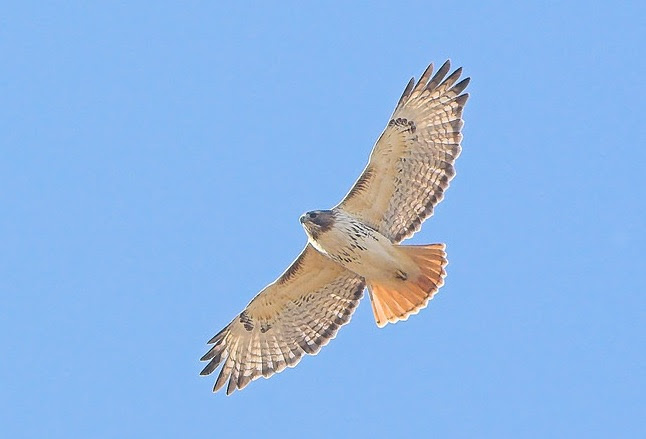Red-tailed Hawk, Buteo jamaicensis
Bill Rowe
High overhead, a hawk is wheeling around, showing you a pale chest with some streaking on the belly—which makes it a Red-tailed Hawk with near-certainty, even if you don’t see the red tail. In many parts of North America, this is the default large hawk, especially in open country, where you may see it scanning for prey from tree limbs or power poles or up in the sky. Since hawks can be confusing, and a given bird may be hard to approach for a good look, it’s helpful to start by trying to place it in a group—in this case, the Buteo hawks, which are rather heavy-set, with wide wings and tail, and range from crow-size to notably larger, like this species. In its diet, the Red-tail is a generalist, adapting to whatever kind of prey is most abundant by place and season; but overall, in the eastern U.S., it mostly takes mammals like rabbits, mice, voles, and squirrels, along with some birds and reptiles. The bulky nest of sticks is built in a tree or occasionally on a building and may be reused for several years. The appearance of Red-tails varies widely across the continent, but, with one exception, adults will show the signature red tail. That exception is “Harlan’s” Red-tailed; it breeds in Alaska and the Yukon and travels a long way to its wintering grounds in the Great Plains and Midwest.
IDENTIFICATION: Besides the red tail of adults, look for a brown-hooded head, a clear breast with a band of streaks lower down on the belly, and (from below) a dark bar on the leading edge of each wing. Immature Red-tails show the same marks except for the tail, which is brown with many narrow dark bands. In flight, the immature also shows big pale square patches on the outer wings. Some birds from the west or the north, seen here in winter, may be rustier, darker, or even whiter than usual, but will still have the red tail. The “Harlan’s” form is usually blackish with some scattered white mottling and with a gray or whitish tail, banded or not. The variation in Red-tails can be mind-boggling, and it is not always possible to determine which form you are looking at, even with the help of a good field guide—but you can still enjoy watching them.
ST. LOUIS STATUS: A common breeding bird, mostly in semi-open farmland, parks, and even suburban and urban settings. The local population is augmented in fall and winter by Red-tails from other parts of the continent, including “Harlan’s,” which is uncommon but regular here.
Learn more and listen to the calls of Red-tailed Hawks here.




